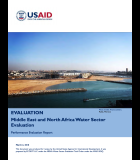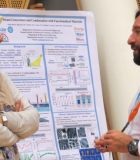Water Information System Platform (WISP)
NASA/WISP activity’s objective is to improve water resources and agricultural management and planning within and across beneficiary countries based on quantitative and spatial-based decision making tools. NASA/WISP activity was developed out of a partnership with the World Bank, in which the World Bank provides funding for purchasing equipment, contracting technical expertise, travel, and training through its Regional Coordination on Improved Water Resources Management and Capacity Building (RCIWRM) project. The USAID-NASA partnership provides technical expertise to participating country institutions in the area of RS and modeling.
Activity Description
The primary objective of the NASA/WISP activity is to achieve improved water resources management and planning across Egypt, Jordan, Lebanon, Morocco and Tunisia. The activity aims to deliver, implement, and operationalize a set of water management tools, WISP, which are based on NASA products and tools customized for each country's specific requirements and capabilities. NASA will develop and transfer WISP tools and data sets to each implementing agency in the participating MENA countries. It can be broken down in three components:
- Improved Local Water Resources and Agricultural Management
- Purchase, installation and validation of various WISP tools and other ancillary equipment to RS centers and stakeholder agencies and institutions in each of Lebanon, Jordan, Morocco and the CRTEAN and its partners;
- Application of WISP tools to pertinent research issues in local and regional water resources, agricultural, and environmental management.
- Applications priorities include identification of drought and flood prone areas, estimation of groundwater fluxes, estimation of evapotranspiration, monitoring climate change impacts, and crop yield estimates to inform agriculture and irrigation management decisions
- Capacity Building and Activity Management
- Capacity building (workshops and consultants) to implement WISP tools;
- Local workshops to share results with local stakeholders; o Participation in international conferences and study tours on environmental RS;
- Funding graduate fellowships;
- Development of an online national portal to share data across stakeholder institutions
- Regional Integration and Cooperation
- Organization of quarterly workshops to share results with regional stakeholders;
- Development of an online regional portal to share regional results;
- Generation of once-yearly regional report on applications of regional significance.
Expected Outcomes
- Compile past and current water conditions to inform improved water policy decisions;
- Generate maps of soil wetness and estimates of irrigation water use for large scale agricultural productivity assessments and planning;
- Provide water balance data for a regional and temporal perspective to identify local, short term and long term trends in water usage anomalies;
- Monitor extent and severity of droughts;
- Estimate current water storage conditions in the uplands of river basins to improve river flow predictions and;
- Evaluate potential increases/decreases in irrigation water requirements under various climate change scenarios to inform the planning of agricultural policies.
Actual Outcomes
- Morocco: WISP has helped install and train users in 12 Land Information System water models selected for implementation to determine floods and quantify water resources, drought-early warning systems, flood detection and modelling, and crop mapping and irrigation.
- Jordan: The cooperation between MWI and the University of Jordan has accomplished the crop mapping and evapotranspiration component has had some promising results to date.
- Tunisia: the National Council for Scientific Research (CNRS), has been effective at using the limited assistance it received in training and capacity building to make progress in the primary areas of floods, droughts, evapotranspiration, and crop mapping. Sustainable management of natural resources and real time assessments of droughts, floods and fires were the driving force for its efforts. Links have been established with stakeholders and end users such as the Ministries of Water Resources, Forestry and Agriculture, farmers associations, and civil aviation.






